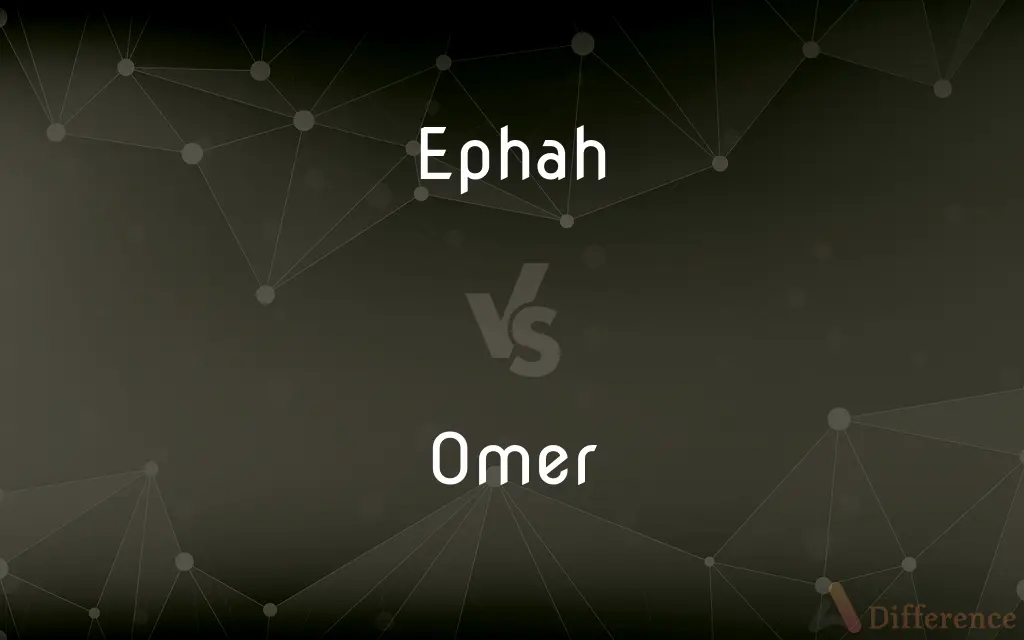Ephah vs. Omer — What's the Difference?
By Tayyaba Rehman & Maham Liaqat — Updated on April 7, 2024
Ephah is a Biblical unit of dry volume, larger than an omer, which represents about one-tenth of an ephah.

Difference Between Ephah and Omer
Table of Contents
ADVERTISEMENT
Key Differences
Ephah and omer are ancient units of dry volume used in the Bible, primarily for measuring grains such as wheat and barley. The ephah is the larger unit, with the omer being defined as one-tenth of an ephah. This relationship signifies the omer's role as a subdivision of the ephah, allowing for smaller quantities to be measured and recorded in the context of ancient Israelite society and religious practices.
In terms of biblical references, both units are mentioned in the context of offerings and daily sustenance. For example, the omer is famously associated with the quantity of manna collected by the Israelites each day during their wanderings in the desert, as detailed in the Book of Exodus. The ephah, on the other hand, is often referenced in laws concerning offerings and sacrifices, indicating its use in more formal religious contexts.
The ephah was used as a standard measure for agricultural products and trade, reflecting its importance in the economic life of ancient Israel. The omer, being a smaller unit, was practical for daily use, such as distributing food or small-scale trading. This distinction underscores the different roles these measures played in the society of the time.
While exact modern equivalents are debated among scholars, the ephah is generally estimated to be equivalent to approximately 22 liters (about 5.8 gallons), making the omer approximately 2.2 liters (about 0.58 gallons). These estimates help to contextualize the biblical narratives, giving modern readers a sense of the scale and significance of these measurements in ancient times.
Despite the historical and cultural distance, the ephah and omer continue to be of interest to scholars, religious practitioners, and those curious about biblical history. They serve as a window into the daily life and religious practices of ancient Israel, illustrating how even basic measures of volume can reflect broader social and religious realities.
ADVERTISEMENT
Comparison Chart
Relative Size
Larger unit of volume
One-tenth of an ephah
Biblical References
Used in offerings, sacrifices
Collected daily as manna in the desert
Practical Use
Agricultural products, trade
Daily food distribution, small trades
Modern Equivalent
Approximately 22 liters (5.8 gallons)
Approximately 2.2 liters (0.58 gallons)
Cultural Significance
Economic and religious life of ancient Israel
Daily sustenance and religious observance
Compare with Definitions
Ephah
Reflects its significance in religious and economic activities.
The ephah is mentioned in the context of legal and religious texts, underscoring its importance.
Omer
Reflects the practical aspects of daily life and survival.
The reliance on the omer for daily food underscores the challenges faced by the Israelites.
Ephah
Indicates its role in the economy for measuring agricultural products.
Merchants in ancient times might have used an ephah to measure grain for sale.
Omer
Connected to survival and daily religious observance.
The collection of an omer of manna is a key event in the narrative of Exodus.
Ephah
Served as a standard measure in ancient Israel.
The ephah was a common measure for grains and possibly other dry goods.
Omer
A smaller biblical unit of volume, one-tenth of an ephah, associated with daily sustenance.
Each Israelite collected an omer of manna daily in the desert.
Ephah
A biblical unit of dry volume, larger and used for significant measurements like offerings.
An ephah was often required for grain offerings in ancient religious ceremonies.
Omer
Suited for smaller, everyday measurements and distributions.
The omer was practical for daily distribution of food like manna.
Ephah
Offers insight into the economic and religious practices of the time.
The use of the ephah in offerings highlights the structured nature of religious observances.
Omer
Facilitated the division of food and goods in smaller quantities.
Families might have measured their daily grain consumption in omers.
Ephah
Ephah (, Hebrew: עֵיפָה ‘Êp̄āh, Septuagint Γαιφα, Gaipha) was one of Midian's five sons as listed in the Hebrew Bible. Midian, a son of Abraham, was the father of Ephah, Epher, Enoch, Abida, and Eldaah by his wife Keturah (Genesis 25:4 ; 1 Chronicles 1:33).
Omer
An ancient Hebrew unit of dry measure equal to a tenth of an ephah, about 3.5 liters (3.7 quarts).
Ephah
An ancient Hebrew unit of dry measure, equal to a tenth of a homer or about one bushel (35 liters).
Omer
An offering of a sheaf or an omer of the first harvest of barley to a priest in the Temple on the second day of Passover.
Ephah
A former Hebrew unit of dry volume (about 23{{nbsp}}L).
Omer
Omer A 49-day liturgical season, originally a harvest festival, from the second day of Passover to the first day of Shavuot, during which marriages are prohibited and signs of mourning are observed.
Ephah
A Hebrew dry measure, supposed to be equal to two pecks and five quarts. Ten ephahs make one homer.
Omer
A former small Hebrew unit of dry volume equal to about 2.3{{nbsp}}L or 2.1{{nbsp}}quarts.
Ephah
An ancient Hebrew unit of dry measure equal to about a bushel
Omer
A vessel of one omer.
Omer
(Judaism) The sheaf of barley offered on the second day of Passover.
Omer
(Judaism) The counting of the omer, that is, the period of 49 days between Passover and Shavuot.
Omer
A Hebrew measure, the tenth of an ephah. See Ephah.
Common Curiosities
Do the ephah and omer have cultural significance today?
While not used in practical terms, they hold cultural and historical significance, especially in studies of biblical history and ancient economies.
What is an ephah?
An ephah is a unit of dry volume used in ancient times, particularly in biblical contexts, for significant measures like offerings.
Can we convert ephahs and omers to modern units?
Yes, scholars estimate the ephah to be about 22 liters, making the omer approximately 2.2 liters, though exact conversions may vary.
What does the reliance on the ephah and omer tell us about ancient Israelite society?
It reflects the agrarian nature of their economy, the importance of religion in daily life, and their practices of trade and sustenance.
Are there modern equivalents to the ephah and omer in use today?
Modern units like liters and gallons serve similar purposes but are part of a more standardized and international system of measurement.
Why were the ephah and omer important in biblical times?
They were crucial for economic transactions, religious offerings, and daily sustenance, reflecting their importance in both daily life and religious practices.
How did ancient societies measure an ephah or omer?
They likely used standardized containers or measures, though the exact methods may have varied across locations and periods.
Did other ancient civilizations use measures similar to the ephah and omer?
Yes, many ancient civilizations had their own systems of measurement, some of which might have been comparable to the ephah and omer.
How do biblical scholars determine the sizes of the ephah and omer?
Scholars use historical texts, archaeological evidence, and comparisons with other ancient measurement systems to estimate their sizes.
How much is an omer?
An omer is one-tenth of an ephah, a smaller unit of volume used for daily measurements, such as the amount of manna collected by the Israelites.
Can understanding the ephah and omer enhance biblical studies?
Yes, it can provide deeper insights into the narratives, cultural practices, and historical contexts of the Bible.
Were the ephah and omer used for liquids or solids?
They were primarily units of dry volume, used for measuring solids like grains.
How accurate are biblical measurements like the ephah and omer?
While the biblical texts provide specific ratios (e.g., the omer as one-tenth of an ephah), the exact volumes may have varied in practice.
Why study ancient units like the ephah and omer?
Understanding these units offers insights into the economic systems, daily life, and religious practices of ancient cultures.
Is there a difference in the use of ephah and omer between different biblical texts?
Their use is consistent across biblical texts, but the context varies from economic transactions to religious practices.
Share Your Discovery

Previous Comparison
Aww vs. Awe
Next Comparison
Character vs. ReputationAuthor Spotlight
Written by
Tayyaba RehmanTayyaba Rehman is a distinguished writer, currently serving as a primary contributor to askdifference.com. As a researcher in semantics and etymology, Tayyaba's passion for the complexity of languages and their distinctions has found a perfect home on the platform. Tayyaba delves into the intricacies of language, distinguishing between commonly confused words and phrases, thereby providing clarity for readers worldwide.
Co-written by
Maham Liaqat















































